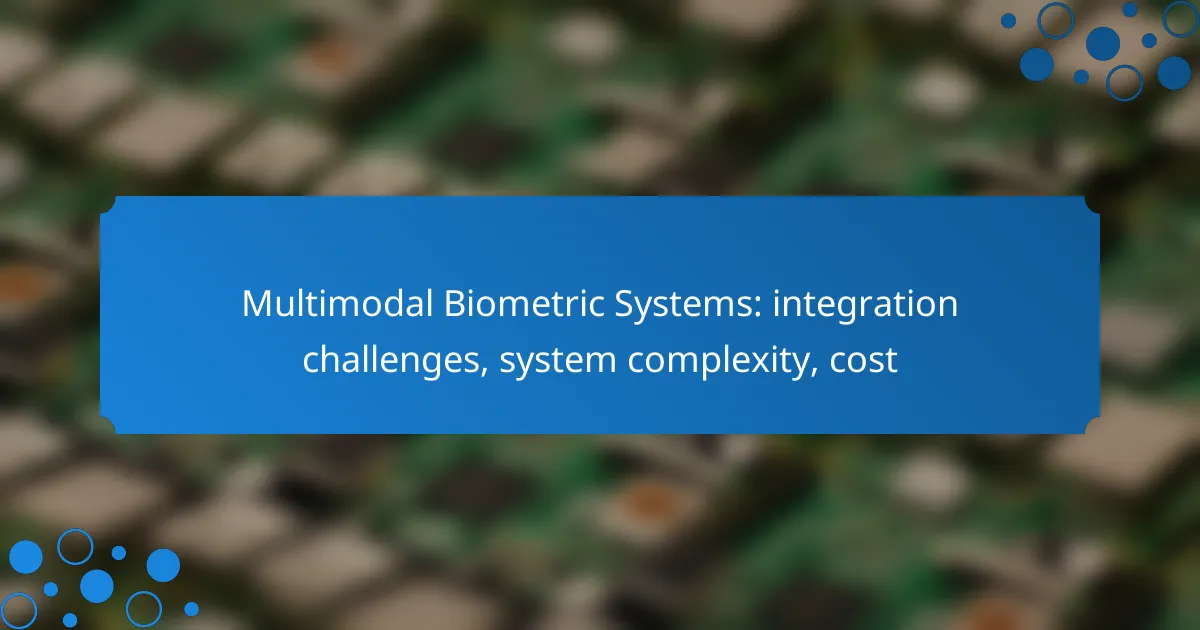Multimodal biometric systems present unique integration challenges, particularly in areas such as data interoperability, regulatory compliance, and user acceptance. The complexity of these systems can lead to increased maintenance demands and potential failures, necessitating robust management protocols. Additionally, organizations must carefully consider the various cost factors associated with implementation and ongoing operations to ensure a sustainable investment.

What are the integration challenges of multimodal biometric systems in Canada?
Multimodal biometric systems in Canada face several integration challenges, including data interoperability, regulatory compliance, technical compatibility, user acceptance, and cost considerations. Addressing these issues is crucial for successful implementation and operation.
Data interoperability issues
Data interoperability issues arise when different biometric modalities, such as fingerprint and facial recognition, fail to communicate effectively. This can lead to inconsistencies in data processing and user identification. Ensuring that systems can share and interpret data across various platforms is essential for seamless integration.
To mitigate these challenges, organizations should adopt standardized data formats and protocols. This approach enhances compatibility and reduces the risk of errors during data exchange.
Regulatory compliance hurdles
In Canada, organizations must navigate a complex landscape of privacy laws and regulations when implementing multimodal biometric systems. Compliance with the Personal Information Protection and Electronic Documents Act (PIPEDA) is critical, as it governs how personal data is collected, used, and disclosed.
Organizations should conduct thorough assessments of their biometric systems to ensure they meet regulatory requirements. Regular audits and updates to privacy policies can help maintain compliance and build trust with users.
Technical compatibility problems
Technical compatibility problems can arise when integrating different biometric technologies and hardware. Variations in software architectures and device specifications may hinder the functionality of multimodal systems. Ensuring that all components work together smoothly is vital for system performance.
To address these issues, organizations should select biometric technologies that are known for their compatibility with existing systems. Conducting pilot tests can also help identify potential integration challenges before full-scale implementation.
User acceptance and training
User acceptance is a significant challenge when implementing multimodal biometric systems. Users may be hesitant to adopt new technologies due to privacy concerns or unfamiliarity with the systems. Providing adequate training and education can help alleviate these fears and promote acceptance.
Organizations should focus on demonstrating the benefits of biometric systems, such as enhanced security and convenience. Engaging users through workshops or informational sessions can foster a positive attitude towards the technology.
Cost of integration
The cost of integrating multimodal biometric systems can be substantial, encompassing hardware, software, and ongoing maintenance expenses. Organizations must carefully evaluate their budgets and consider the long-term return on investment when implementing these systems.
To manage costs effectively, organizations should explore scalable solutions that allow for gradual implementation. Prioritizing essential features and functionalities can also help minimize initial expenditures while still achieving desired outcomes.

How does system complexity affect multimodal biometric systems?
System complexity significantly impacts multimodal biometric systems by increasing maintenance demands and the likelihood of failures. As these systems integrate multiple biometric modalities, they require more sophisticated management and troubleshooting protocols to ensure reliability and user satisfaction.
Increased maintenance requirements
Multimodal biometric systems necessitate regular maintenance due to their intricate nature. Each biometric modality, such as fingerprint, facial recognition, or iris scanning, may require distinct upkeep procedures, leading to higher operational costs. Organizations should prepare for ongoing software updates and hardware checks to maintain system integrity.
Additionally, training personnel to handle various biometric technologies can further complicate maintenance efforts. Investing in comprehensive training programs can mitigate risks associated with improper handling or system misuse.
Higher risk of system failures
The integration of multiple biometric systems can elevate the risk of failures, as each component introduces potential points of malfunction. For instance, if one biometric sensor fails, it may compromise the entire system’s functionality. Organizations should implement redundancy measures, such as backup sensors, to minimize the impact of individual component failures.
Moreover, the complexity of data processing and fusion algorithms can lead to delays or inaccuracies in user identification. Regular testing and validation of the system can help identify weaknesses and enhance overall reliability.
Challenges in user experience
System complexity can hinder user experience by creating longer authentication times and potential confusion during the enrollment process. Users may become frustrated if they must navigate multiple biometric modalities, especially if the system does not clearly communicate the required actions. Simplifying the user interface and providing clear instructions can improve overall satisfaction.
Furthermore, if users encounter frequent errors or delays, they may lose trust in the system’s effectiveness. Organizations should prioritize user feedback and continuously refine the system to ensure a seamless and efficient experience.

What are the cost factors for implementing multimodal biometric systems?
The cost factors for implementing multimodal biometric systems include initial setup costs, ongoing operational expenses, and the cost of updates and maintenance. Understanding these elements is crucial for organizations considering such systems, as they can significantly impact the overall budget.
Initial setup costs
Initial setup costs for multimodal biometric systems can vary widely based on the technology chosen and the scale of implementation. Expenses typically include hardware purchases, software licensing, and integration services. Organizations should budget for tens of thousands to potentially hundreds of thousands of dollars, depending on the complexity of the system.
Additionally, training staff to use and manage the new system can add to initial costs. It’s advisable to conduct a thorough cost-benefit analysis to ensure that the investment aligns with organizational goals.
Ongoing operational expenses
Ongoing operational expenses encompass costs related to system maintenance, user support, and data storage. These costs can be substantial, often amounting to a percentage of the initial investment annually. Organizations should expect to allocate a budget for regular updates and potential scalability as user numbers grow.
Moreover, energy consumption for running biometric devices and servers should not be overlooked. Implementing energy-efficient solutions can help mitigate these ongoing costs over time.
Cost of updates and maintenance
The cost of updates and maintenance is a critical factor in the long-term sustainability of multimodal biometric systems. Regular software updates are necessary to enhance security and functionality, which may incur additional licensing fees. Organizations should plan for these costs as part of their annual budget.
Maintenance can also include hardware repairs or replacements, which can be unpredictable. Establishing a maintenance contract with vendors can provide financial predictability and ensure timely support when issues arise.

What criteria should be considered when selecting a multimodal biometric system?
When selecting a multimodal biometric system, key criteria include scalability, vendor reputation, and ongoing support. These factors influence not only the system’s performance but also its long-term viability and adaptability to changing needs.
Scalability of the solution
Scalability refers to the system’s ability to handle increasing amounts of data or users without compromising performance. A well-designed multimodal biometric system should accommodate growth, whether that means adding new biometric modalities or expanding user capacity.
Consider systems that allow for modular upgrades, enabling you to integrate additional biometric technologies as needed. For example, a system that starts with fingerprint and facial recognition can later include iris scanning without a complete overhaul.
Vendor reputation and support
Choosing a vendor with a strong reputation and reliable support is crucial for the successful implementation of a multimodal biometric system. Research vendors’ track records, customer reviews, and case studies to gauge their reliability and effectiveness.
Additionally, assess the level of technical support offered. A vendor that provides comprehensive training, timely updates, and responsive customer service can significantly reduce downtime and enhance user satisfaction. Look for vendors with established partnerships and certifications in biometric technology to ensure quality and compliance with industry standards.

How do multimodal biometric systems compare to traditional biometric systems?
Multimodal biometric systems utilize multiple biometric identifiers, such as fingerprints and facial recognition, to enhance performance compared to traditional systems that rely on a single identifier. This integration improves accuracy, security, and user convenience, making it a preferred choice in various applications.
Enhanced accuracy and security
Multimodal biometric systems significantly reduce false acceptance and rejection rates by cross-verifying multiple biometric traits. For instance, combining fingerprint and iris recognition can achieve accuracy rates exceeding 99%, compared to lower rates for single-modality systems.
Additionally, the use of multiple identifiers makes it more difficult for unauthorized users to spoof the system. This layered security approach is particularly beneficial in high-stakes environments like banking and government facilities, where the risk of fraud is substantial.
Broader application scenarios
With their enhanced capabilities, multimodal biometric systems are applicable in a wider range of scenarios, from secure access control to identity verification in mobile devices. For example, smartphones often use facial recognition along with fingerprint scanning to ensure user authentication.
Moreover, these systems can adapt to various environmental conditions and user preferences, making them suitable for diverse industries such as healthcare, travel, and law enforcement. This flexibility allows organizations to implement tailored solutions that meet specific security and operational needs.
